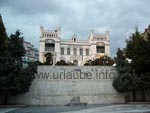|
|
|
Kavalla - Trip to eastern Macedonia
Ongoing to our tour through the city of Thessaloniki, we visited Kavalla, the biggest city of eastern Macedonia. We first visit the peninsula with the old town, before we continue into the new town. The Oldtown PeninsulaFrom the motorway A2, one gets, after approximately 170 kilometres, from Thessaloniki to Kavalla, that with 70.000 inhabitants is the biggest city of east Macedonia. By passing dry and hilly landscapes and a huge lake, the trip took approximately two hours on the little used asphalt surface, that is repeatedely interrupted by country road sections. But at the time of our stay there was already busily worked on it to build the missing parts of the roadway arrangement, so that in the future, the progressing will be even faster. 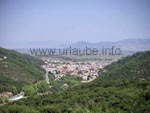
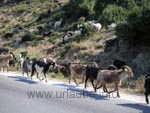
In the early morning, we already get started for our tour to Kavalla, in order to continue after that for a little city sightseeing with the ferry to the island Thassos. It was supposed to be the longest, but surely also the most impressive day of our holiday. The 40 kilometres on the varied country roads, that leads from Paleochori through Eleftheroupoli to Kavalla, spun away, and even the desired herd of goats, that until then was still missing in our travel impressions, was visible to us from the middle of the road. However, the enthusiasm of the graced triune femaleness on the back seat seemed interminable. But in fact it was always interminable, and the thought of three shaggy felt balls with saucer eyes dangling from the ceiling in the back part of the car that were continuously screaming "Jippieh!", was very meaningful tu us men. By saying any catchword, the even sang a song that contained this word. Oftenly, it was even the same song. This is the way to spend the time if the car radio does not work. 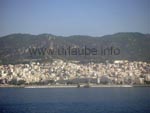
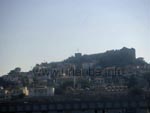
Once arrived in Kavalla, we first went in serpentines through the densely built bottom of the Simvolo-Mountains down to the harbour, with a view at one side to the historical city centre with its impressive city wall and the fortress of ottoman times (1425), and at the other side the sea, harbour and the island Thassos that is in front of the mainland. The rest of the picture that is offered from above, is dominated by a sea of white houses, in that we entered deeper and deeper. But apart from this views, the deeper we got into the real city, the less of urbanistic beauty was visible, as the living blocks of several floors that appear on the streets seemed to be more functional and optically not very attractive. 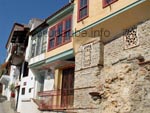
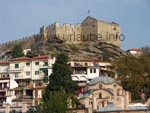
But then we arrived through the Odós T. Poulidou in the oldest city district of Kavalla, where first the Imaret, a long extended building that was built in 1817 by Muhammad Ali Pascha caught our eye, that was originally a mosque, a koran school and an almshouse. Typical of the arquitecture of the ottomans are numerous little minarets, arcs and cupolas, that also adorned this building; the interior was embossed by filigree and atmospherically designed aureoles and arches. Since a costly restauration, the complex is today an exclusive hotel with an oriental ambiance and view to the harbour, that is one of the most important sea, ferry and fishing harbour of eastern Macedonia. Today, Imaret belongs to the most beautiful, atmospheric and expensive accomodations of Greece (room from 220 €). 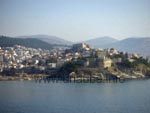
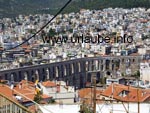
This oriental flair is seamlessly continued throughout the turkish district Panagia. It is located at the outermost cone point of the peninsula of the old town and seems to be particularly crooked, colourful, narrow and cosy. In the centre of Panagia there is the Panagia church that neither cannot deny its arquitectural origin, and the house of birth of Muhammad Ali Pascha. But also the influence of the roman arquitecture is noticeable in the old town of Kavalla at the place of the antique Akropolis, where today, the byzantine citadel with its tower with a height of 20 metres is placed in the centre. The Kamares and a double-floored aqueduct with a height up to 60 metres, was rebuilt true to original in the year 1550 by Süleyman I the Magnificient and bridges over a little valley. From there, it was not far to go up to the fortress and due to the reason it was still quite early, the temperatures were also moderated and the march up to the steeply hill was not a problem. For a little entrance fee we could have also seen the interior of the ruin, but only the view from the massive wall over Kavalla was so enduringly impressive, that we wanted to save our time for Thassos and went back to the old town with its interesting play of lights and shades. After the first episode of culture of the day, we first had a little break in one of the little taverns, of which there are plenty in the old town, beside bars and different little shops. New town of Kavalla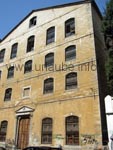
After we enjoyed for half an hour the mediterranean flair of Kavalla by having a frappé, we then continued to the new town, that is less than one kilometre away. There, it was clearly noticeable which economic good led the city in the 18th century to this immense growth: the tabac cultivation. We reached the centre, the Platia 28is, through the Erithroú Stavroú. Large and partly quite decayed factory buildings that in former times served for the dehytration, storage and further proceeding of the tabac, and magnifient buildings of the time around 1900, thereunder also the
Here, traditional and historical buildings are mixed with modern ones, what does indeed not work everywhere, but still arranges a special appeal, as the city parts of historical relevance as the old town and the historical new town form a harmonic and uniform picture. The environment of the old town of the new town is formed by high living complexes, big plazas and department stores, so that many people can live in the quite small space offered by the hillside situation. But in order not to oversaturate the mind with culture and to grant the body its well earned break, after all, the thermometre passed the 35 degrees mark, we leaved Kavalla at noon time and went into the direction of Thassos, to explore the famous beaches there and to round the island. Indeed, close to Kavalla there are also white sand beaches, but in case of Thassos it is said that it offers additionllay some special attractions with its landscape. We wanted to convince ourselves of this. 
Back to the index Thessaloniki Copyright: Patrick Wagner, www.tourist-guide.biz |
||
